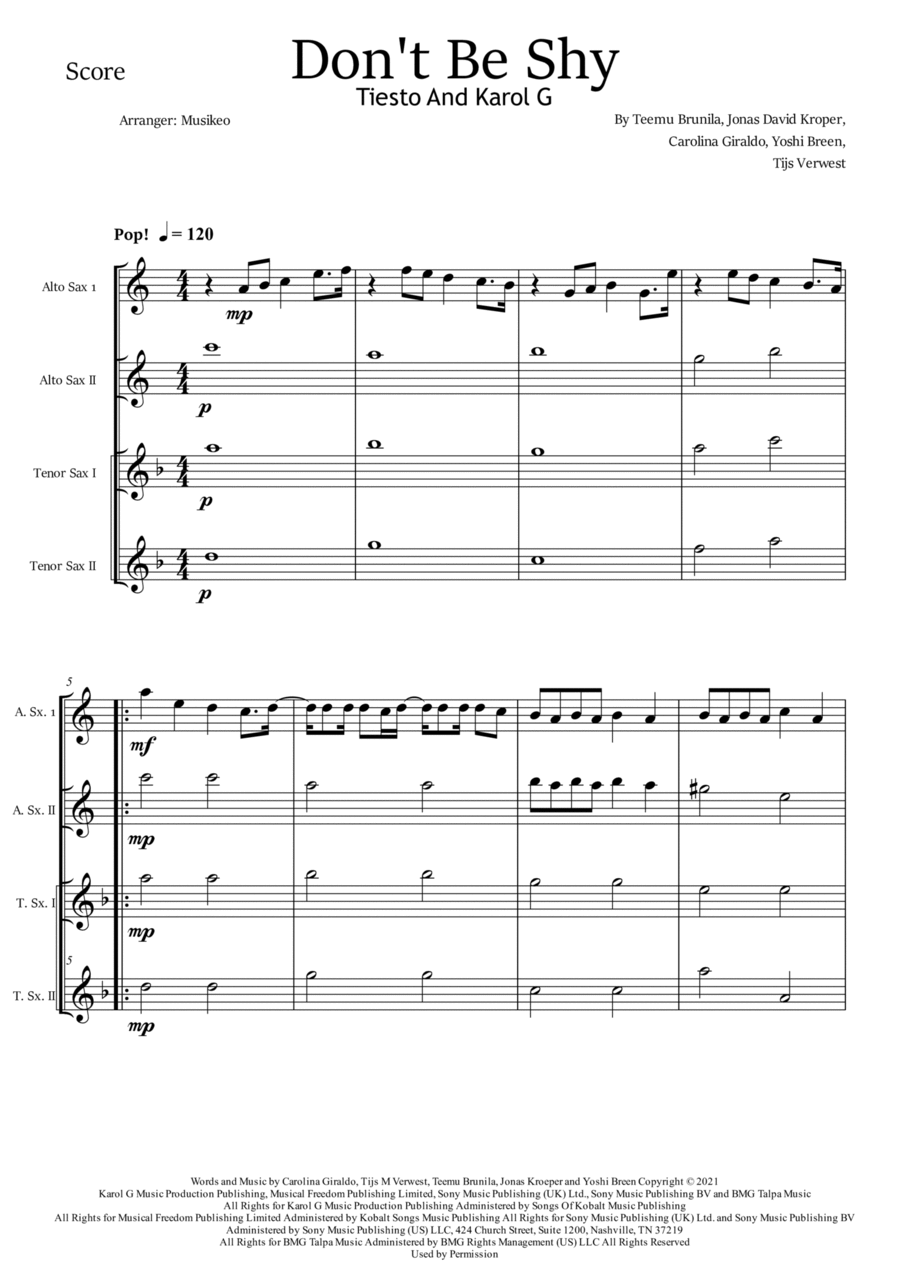Saxophone Quartet,Woodwind Ensemble Alto Saxophone,Tenor Saxophone - Level 2 - Digital Download SKU: A0.1237552 By Tiesto And Karol G. By Carolina Giraldo, Jonas David Kroper, Teemu Brunila, Tijs Verwest, and Yoshi Breen. Arranged by Musikeo. 21st Century,Contemporary,Disco,Latin,Pop. 8 pages. Musikeo #833069. Published by Musikeo (A0.1237552). Don't Be Shy is a song by Dutch DJ Tiësto and Colombian singer-songwriter Karol G. It was released on 12 August 2021 via Atlantic Records as a the second single from Tiësto's seventh studio album Drive. It also marks Karol G's first song in English.The music video was directed by Christian Breslauer, who filmed the music videos for The Business, Industry Baby and Streets. It starts off with an outdoor shot of the Norwegian National Opera and Ballet at the Night, then followed up by the Night at the Museum-inspired music video, comedian Blake Webber plays a museum janitor, and Karol G dances with a group of dancers in different scenes in a museum.Part two of the music video was released on 4 September 2021.Carolina Giraldo Navarro (born 14 February 1991), known professionally as Karol G (stylized in all caps), is a Colombian singer and songwriter. She is predominantly described as a reggaeton and Latin trap artist, but has experimented with a variety of other genres including reggae and sertanejo. In 2018, she won the Latin Grammy Award for Best New Artist, and has been nominated for several Billboard Latin Music Awards and Lo Nuestro Awards.Born and raised in MedellÃn, Giraldo launched her career as a teenager, appearing on the Colombian spinoff of The X Factor. She moved to New York City in 2014 to learn more about the music industry and signed to Universal Music Latino. Her collaboration with Puerto Rican rapper Bad Bunny Ahora Me Llama became her breakthrough hit, and was the lead single for her debut album Unstoppable, released in 2017. In late 2018, her song Secreto became a hit in Latin America as she and Anuel AA publicly confirmed their relationship in the music video.In July 2019, she released China in collaboration with Anuel AA, Daddy Yankee, Ozuna and J Balvin, which became her first music video with over one billion views on YouTube. In May 2019, she released the album Ocean, which served as a stylistic departure from Unstoppable, incorporating a more relaxed atmosphere in her work. Her song Tusa with Nicki Minaj also charted internationally and was certified 28× Latin Platinum by the RIAA, staying on the Billboard Hot Latin Songs chart for 25 weeks. In 2020, Karol G received four nominations at the Latin Grammys. Karol G achieved her highest-charting single on the Billboard Hot 100 with the top 10 song TQG, a collaboration with Shakira.With her fourth album, Mañana Será Bonito (2023), Karol G became the first woman to ever debut at number one on the Billboard 200 chart with a Spanish-language albumEnjoy my sax quartet arrangement!
